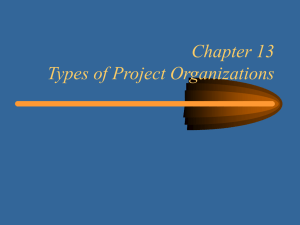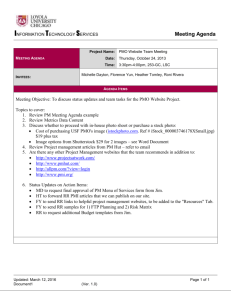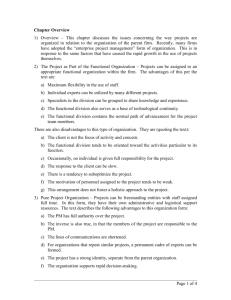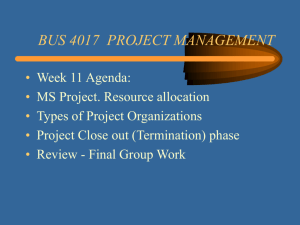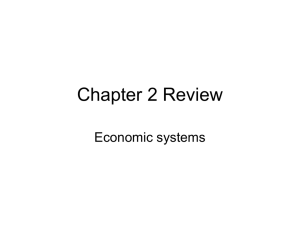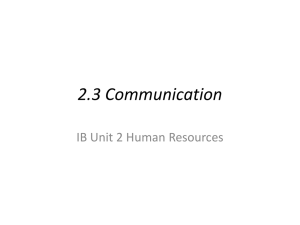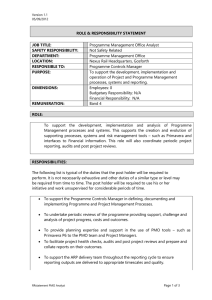Chapter 13
advertisement
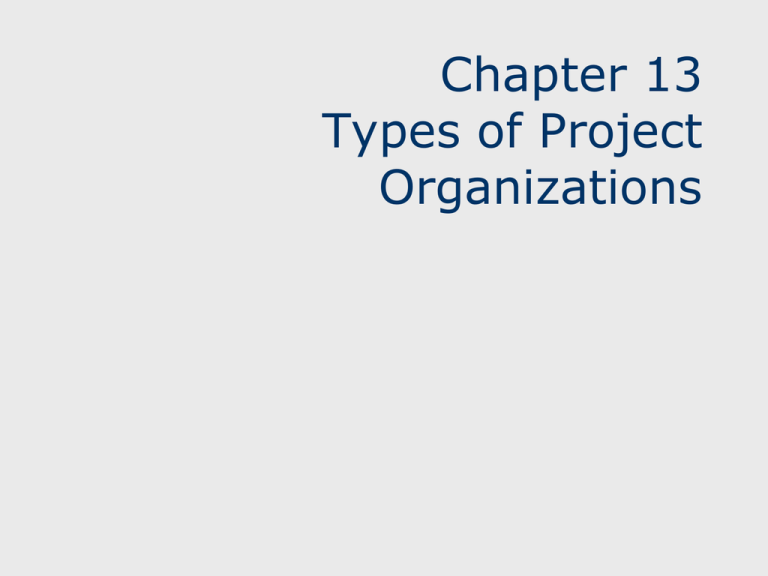
Chapter 13 Types of Project Organizations Learning Objectives The characteristics of the three types of organization structures: - functional - project - matrix The advantages and disadvantages of each 2 Real World Example Vignette: The Customer is Always Right NCR Financial Solutions Group Ltd., Dundee, Scotland The program management office (PMO) realized that they were missing internal customer commitments and projects goals were not being met. The PMO determined three levels of internal customer bases and four types of external customers. They started a rigorous training program for project managers to improve their skillset and receive PMI certification. After making these improvements the PMO has seen a 3040 % reduction in cycle time over a five-year period. 3 Real World Example Vignette: What’s Your Organizational Quotient? It is critical to understand the collaborations, relationships, and networks of the informal organization. “OQ” is the ability to balance both formal and informal power structures Some of the issues that are common among most companies are: Need for ways to energize a sluggish working environment. Problem in grooming future leadership. Existence of poor social networks and communications among executive leadership teams. Lack of informal social networks / ties between employee teams. 4 Solution: Companies: need to resist the urge to try to micromanage employee relationships. should not completely rely on power structure. senior executives and project managers should try to create loose parameters around informal organizations that operate independently. must locate the right people to place in project management positions. 5 Functional-Type Organization Used in businesses that sell and produce standard products. Groups consist of individuals performing the same function. Periodically undertake in-house projects. Team members can be assigned to the project. Team members continue regular functional jobs. Project manager does not have complete authority over team. 6 FIGURE 13.1 Functional Organization Structure 7 Project-Type Organization Used in companies in the project business, not selling products. Work on multiple projects at a time. Project team is dedicated to one project. Project manager has complete authority over team. Each project team tends to be isolated. 8 FIGURE 13.2 Project Organization Structure 9 Matrix-Type Organization A mix of functional and project organization structures. Used in companies that work on multiple projects at a time. Provides project and customer focus. Retains functional expertise. Individuals can be assigned to various types of projects. 10 Matrix-Type Organization (Cont.) Both project managers and functional managers have responsibilities. The Project Manager is the intermediary between customer and company. The Functional Manager decides how tasks will be accomplished. 11 FIGURE 13.3 Matrix Organization Structure 12 Functional Organization Advantages Reduces duplication and overlap of activities. Provides specialization and functional excellence. 13 Functional Organization Disadvantages Can be insular. Teamwork is not emphasized. Decisions may be parochial. Structure can slow communication, problem solving and decision making. Lack of customer focus. Stronger allegiance to function than project. 14 Project Organization Advantages Team has full control over resources. Organization is highly responsive to customer. 15 Project Organization Disadvantages Can be cost inefficient. Tendency to stretch out work during slow periods. Potential for duplication on concurrent projects. Low level of knowledge transfer. No functional “home”. People may be laid off at the end of the project. 16 Matrix Organization Advantages Allows efficient utilization of resources. Provides a core of functional expertise. Facilitates information flow. Individuals can be moved among projects. Learning and knowledge transfer. Improved communication. Customer focused. 17 Matrix Organization Disadvantages Team members have a dual reporting relationship. A proper balance of power must be established between project and functional managers. Conflicts regarding priorities can arise between managers. 18
